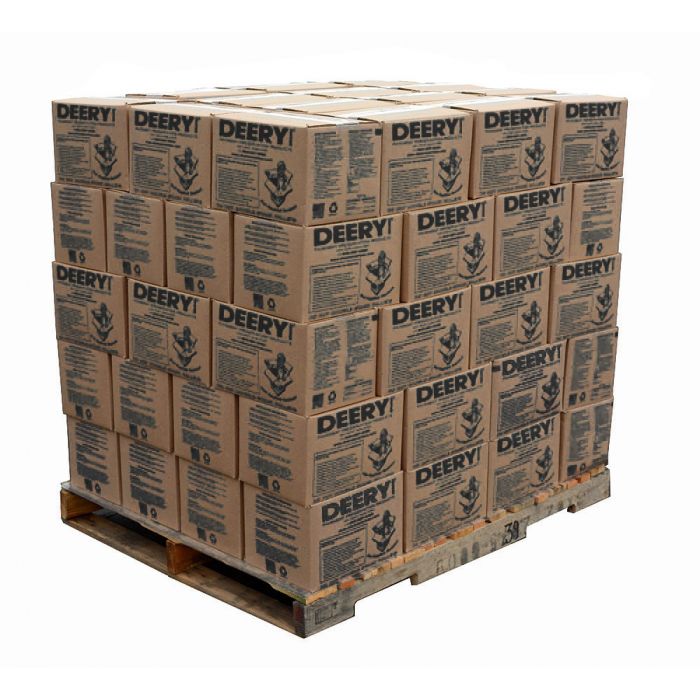Deery PLS Oil Jacketed Crack Filler – Full Pallet (75 Boxes)
Add AK Make it a Biz Success Pack - Free With Purchase

- Use with oil-jacketed melters only
- Ideal for sealing cracks in large parking lots, runways, and roads
- Forms a flexible and water-proof seal
Availability: In stock
Have questions? We’re here to help!

Waterproofing Asphalt Cracks With The Deery PLS Oil Jacketed Crack Filler
Deery PLS Oil Jacketed Crack Filler is a hot-applied crack filler designed to fill cracks in asphalt or concrete where recycled rubber, modifiers, and polymers are approved. This product meets the specification of most states' DOTs and is favored by airports, highways, and roadways.
How Deery PLS Crack Sealer Works
This crack filler is designed to seal cracks water-tight and prevent water from seeping into the foundation of your asphalt which causes further damage to the asphalt. When cracks are left unsealed, water will erode the foundation, leaving a pocket of air where the asphalt cannot bear its own weight and will collapse on itself, causing depressions or potholes.
Deery PLS is designed to be melted down in an oil-jacketed kettle. It is not a direct-fire crack sealer, so it should not be used in the crack filling machines we sell or other direct-fire kettles. Use this product in an oil-jacketed melter that has constant agitation.
Deery PLS crack sealer is generally used for projects that were specified with an oil-jacketed material: municipal roads, interstates, and airport runways. The elasticity in Deery PLS allows for greater expansion in cracks, and it is much more flexible than direct-fire crack fill. This product is designed for fixing cracks in large bodies of asphalt.
Use this oil-jacketed crack filler to seal all asphalt cracks in high-traffic areas and protect the pavement from water, ice, and erosion.
How to Apply Deery PLS Oil Jacketed Crack Filler
Deery PLS can be applied as soon as the pavement is at the recommended temperature: 40°F (4°C) or higher. Next, place the material into a clean, dry crack using a hand-held pour pot, wheeled push bander, or wand applicator. Squeegee any excess sealant tight to the pavement surface.
Heat the product to 380-400°F (193-204°C). Do not heat over 400°F. If the product is held at a higher temperature for a prolonged period, it will damage the product's adherence and performance.
Note: We are pleased to offer FREE SHIPPING within the Continental United States. Additional charges may apply for residential deliveries, limited access locations, lift-gate services, and remote areas. A surcharge of $150 per pallet applies to shipments going to the West Coast (Arizona, California, Colorado, Idaho, Montana, Nevada, New Mexico, Oregon, Utah, Washington, and Wyoming).
For orders shipping to Alaska and Hawaii: We will ship your items to your preferred freight forwarder within the United States. From there, you will handle the arrangements for final delivery to your location.
Have questions? We’re here to help!

| Shipping Weight | 2,354 lbs |
| Shipping Length | 48 |
| Shipping Width | 40 |
| Shipping Height | 48 |
| Half-Pallet |
36 Boxes Product Weight: 1,080 lbs Shipping Weight: 1,220 lbs Shipping Dimension: 48" x 40" x 48" |
| Full-Pallet |
75 Boxes Product Weight: 2,250 lbs Shipping Weight: 2,354 lbs Shipping Dimension: 48" x 40" x 48" |
| 4 Pallets |
300 Boxes Product Weight: 9,000 lbs Shipping Weight: 9,560 lbs Shipping Dimension: 48" x 40" x 48" |
| Flow @ 140°F (60°C) | 3.0 mm maximum |
| Softening Point | 210°F (99°C) minimum |
| Resilience @ 77°F (25°C) | 30% minimum |
| Minumum Application Temperature | 380°F (193°C) |
| Maximum Heating Temperature | 400°F (204°C) |
| Warranty | Manufacturer warrants that these products meet applicable ASTM, AASHTO, Federal or State specifications at time of shipment. Techniques used for the preparation of the cracks and joints prior to sealing or filling are beyond our control as are the use and application of the products; therefore, manufacturer shall not be responsible for improperly applied or misused products. |
0
5 stars
0% (0)
4 stars
0% (0)
3 stars
0% (0)
2 stars
0% (0)
1 star
0% (0)
Share your thoughts with other customers
Top customer reviews
No reviews
Start your Asphalt Maintenance Business with the most in-demand service!
Looking at doing crack repair as a business? Make your success inevitable with these valuable add-ons, yours free with purchase at Asphalt Kingdom!
You get:
- Role-Playing Video with Judd Burdon: find out exactly what to say when you pitch your business to customers, and how to answer their most common objections.
- Crack Filling Proposal Template: a professionally designed form that you can fill in and print off — convert more business when you look pro from the get-go.
- Customizable Social Media Templates: swipe these great graphics and post them on your Facebook or Google My Business pages — get valuable leads with these proven templates!
- Phone Script written by Judd Burdon for you or your sales team to use when prospecting new business.
- Exclusive Access to AK Round Table Meetings: join us on a weekly Zoom call and get answers to any questions you have about your business.
You don't need to spend valuable time learning in the school of hard knocks — take advantage of the experience we've gained helping 1000s of clients start their own business.
Just click 'Make it a Biz' when you add this product to the cart, and we'll send you all of the above absolutely free. Welcome to your asphalt kingdom.









